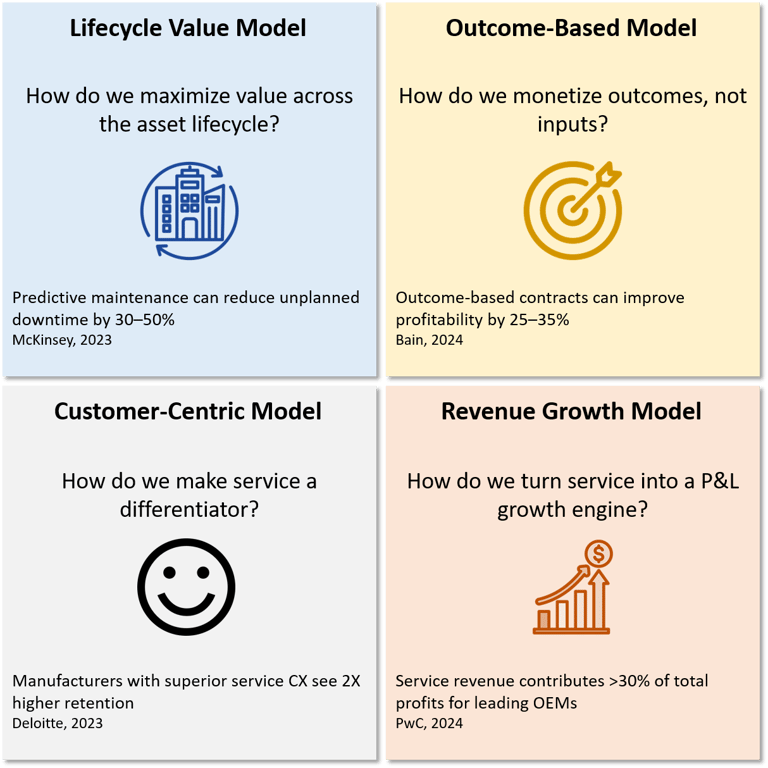Unlocking Service-Led Growth in Manufacturing: From Mindset to Model to Market
Mihir Joshi


Manufacturers today are under no illusion: service is the future. With product margins under pressure and aftermarket opportunities growing, the logic for shifting toward a service-led business model is clear. Yet few organizations make the leap. Many treat service as a support function, not a strategic growth engine, reskinned banners and customer portals aside, the underlying operating model remains product-centric. That misalignment keeps service in the margins rather than at the heart of value creation.
Service-led growth is not about adding tools or a new pricing model - it’s about reframing how an organization creates and captures value. At its best, service becomes the commercial and operational backbone of the business: it stabilizes cash flows, increases customer stickiness, and opens new growth pathways without proportionate expansion of physical capacity.
Unlocking Service-led Growth in Manufacturing
From Mindset to Model to Market
In a product-led business, success is often defined as units sold, installation completed, and revenue booked at sale. In a service-led model, value is defined by what the customer actually achieves over time - uptime, productivity, lifecycle cost, growth.
When service becomes the central business model, the question becomes: how do we deliver value continuously, not only at the point of sale? A service-led strategy asks how we compete through ongoing value delivery - not just through incremental warranty or spare part revenue, but through outcomes that matter to the customer.
What Service-Led Growth Really Means
The case for service-led growth has shifted: no longer only strategic, it is now clearly economic. A recent study by Boston Consulting Group of industrial machinery manufacturers found that in 2023, services revenue grew by roughly 10% over the prior year, with expectations of another ~8% rise in 2024. Moreover, service-based margins are significantly higher than equipment sales margins - in many cases double, for example where equipment margins sit at ~15-25%. Further, industry data shows that service revenues typically represent about 30% of total revenue in industrial companies - in recent years averaging around 31% in 2023.
These numbers matter because they show three things:
Growth potential: services are expanding faster than equipment sales.
Margin improvement: shifted revenue pools deliver higher profitability.
Stability and resilience: service revenue is less lumpy and more tied to installed base than fresh unit sales.
Put simply: shifting toward service-led growth is not an optional bolt-on. It is a lever for commercial performance, margin resilience, and customer value creation.
The Economic Case for Service-Led Growth
Successful service-led strategies don’t rely on one single lever. They combine multiple models to transform the business.
The Strategic Models Behind Service-Led Growth
Lifecycle Ownership: This model extends value beyond the point of sale by capturing uptime, utilization, maintenance and performance across the installed base. It transitions the business from “sell product” to “own outcomes over lifecycle”.
Outcome-Based Value: Here the provider bills not for hours or parts but for performance - units produced, lost downtime avoided, energy consumed, uptime guaranteed. This shifts risk, deepens customer relationships and aligns incentives.
Customer-Centric Portfolios: Rather than generic service contracts, this model offers tiered, modular offerings aligned to customer maturity. Basic support, predictive monitoring, and full performance contracts sit on a continuum, allowing segmentation, pricing discipline and growth.
Recurring Revenue Design: Rather than one-time sales, the business moves toward subscriptions, managed services, renewals, and multi-year agreements. Recurring revenue brings predictability, higher lifetime value and tighter alignment between customer success and provider performance.


Why these four? Because together they cover the key dimensions of strategic change: what you sell, how you deliver it, how you structure the offering, and how you monetize it. Without mastery of all four, many service-growth efforts plateau.
The Building Blocks of a Scalable Strategy
Despite strong intent, many service-led transformations stall, often for organizational, not technical, reasons. Typical breakdowns include ambition remaining at an operational level (for example, “reduce cost per service call” rather than “increase service revenue share”), lack of single owner of the service P&L, misaligned incentives between sales and service, and abundant data collected but little turned into decision-making.
To avoid these traps, five critical building blocks set organizations apart:
Leadership alignment: Sales, Service and Finance must share a growth narrative anchored on service, not operate in silos.
Customer segmentation: Not all customers will pay for outcomes, identify which segments will and design tailored portfolios accordingly.
Pricing discipline: Service pricing must link to measurable customer value (for example, downtime avoided, yield gain) rather than cost-plus margin.
Governance and metrics: KPIs must tie operational performance to financial outcomes (renewal rate, service margin share) rather than only response time or fix-rate.
Change enablement: Culture, incentives, structure and ways of working matter more than technology alone. Legacy mindsets and misaligned incentives are the biggest barrier to scale.
Operating Model Imperative
Shifting to a service-led model is not simply a new offering or contract type, it demands structural change. Organizations must redefine ownership of service P&L, align incentives across functions, and redesign governance to make service decisions strategic. In high-performing companies, a Service Growth Office or equivalent cross-functional governance body sits at the nexus of pricing, service portfolio, data-ops and channel strategy.
Without such clarity, service remains tactical and fragmented. With it, service becomes embedded in commercial decision-making, product design, field operations and customer outcomes. Turning strategy into scale depends on more than vision: it depends on capabilities. Three enablers are critical:
Data & Analytics: Asset intelligence, predictive maintenance and usage telemetry convert installed base into insight and monetizable value.
Technology Platforms: Digital service platforms, remote monitoring, field-service apps, and IoT become the operational backbone of outcome models.
Talent & Organization: Service teams must transition from reactive fixers to proactive value creators. Commercial acumen, customer success orientation and data fluency become required skills.
Improving customer journeys by one point (10-point scale) correlates with at least 3% higher revenue growth.
Leadership must recognize that investment in tools without corresponding investment in behaviours, processes and organisation will fail.
What Service-Led Growth Looks Like in Practice
Transformation is not about the tool, it’s about how people, process and performance work together.
People: Service teams shift from reactive problem-solvers to proactive value creators. Roles are redesigned around outcomes (uptime, sustainability, efficiency) rather than tasks.
Processes: Instead of focusing solely on response time or fix rate, the organization aligns around value metrics such as renewal rate, lifetime service margin or asset uptime.
Performance: Data and technology play an enabling role — but the differentiator is how insights are operationalized. In leading firms, feedback from the field drives product design, pricing decisions and customer experience strategy in close to real time.
This alignment of people-process-performance forms the engine of service-led growth.
Applying insights across the customer journey can boost services revenue by 10 percent or more - an amount that can translate to hundreds of millions in revenue for larger OEMs.
The Service Growth Playbook
The playbook for service-led growth is not a checklist of tools, it is a structured approach to evolution. Every transformation starts with a clear understanding of where you stand. The following framework would help organizations evaluate their maturity and build a scaleable Service-led business:
Define Your North Star: e.g., increase service revenue share to 30 % of total revenue within three years; or improve customer-up-time KPI by 15 %.
Revisit the Portfolio: Map existing services by growth potential and differentiation; categorise into basic support, value enhancement, outcome guarantee.
Rethink Value Delivery: Redesign offerings in customer language: what outcome matters most? Structure pricing accordingly.
Align Incentives & Metrics: Ensure Sales, Service and Finance share common KPIs tied to customer outcomes and revenue resilience.
Start Small, Scale Smart: Pilot in a region or product line, measure impact, document the playbook, then deploy enterprise-wide with governance.
This downloadable Service-Led Growth Readiness Checklist helps leaders assess maturity across five dimensions: leadership alignment, portfolio strategy, commercial model maturity, data capability and cross-functional collaboration.
Ready to see where you stand?
Download the free Service-Led Growth Checklist to assess your organization’s readiness and identify the next best moves toward a lifecycle-driven business model.
The Path Forward: Growth Hidden in Plain Sight
While the industry debates digital twins, quantum-driven optimization and next-gen analytics, the real opportunity for many manufacturers lies not in chasing what’s next - but executing what’s already present. Service-led growth is not a future concept. It is a performance discipline. The next step is leadership conviction. Service cannot be delegated to operations alone, it must be designed and governed strategically. Manufacturers that treat service as strategy, not support, will define the next era of industrial advantage.
Author Info
Written by Mihir Joshi
After 15 years working with leading manufacturers, I created SmartServiceOps to share practical insights for the field service industry.
